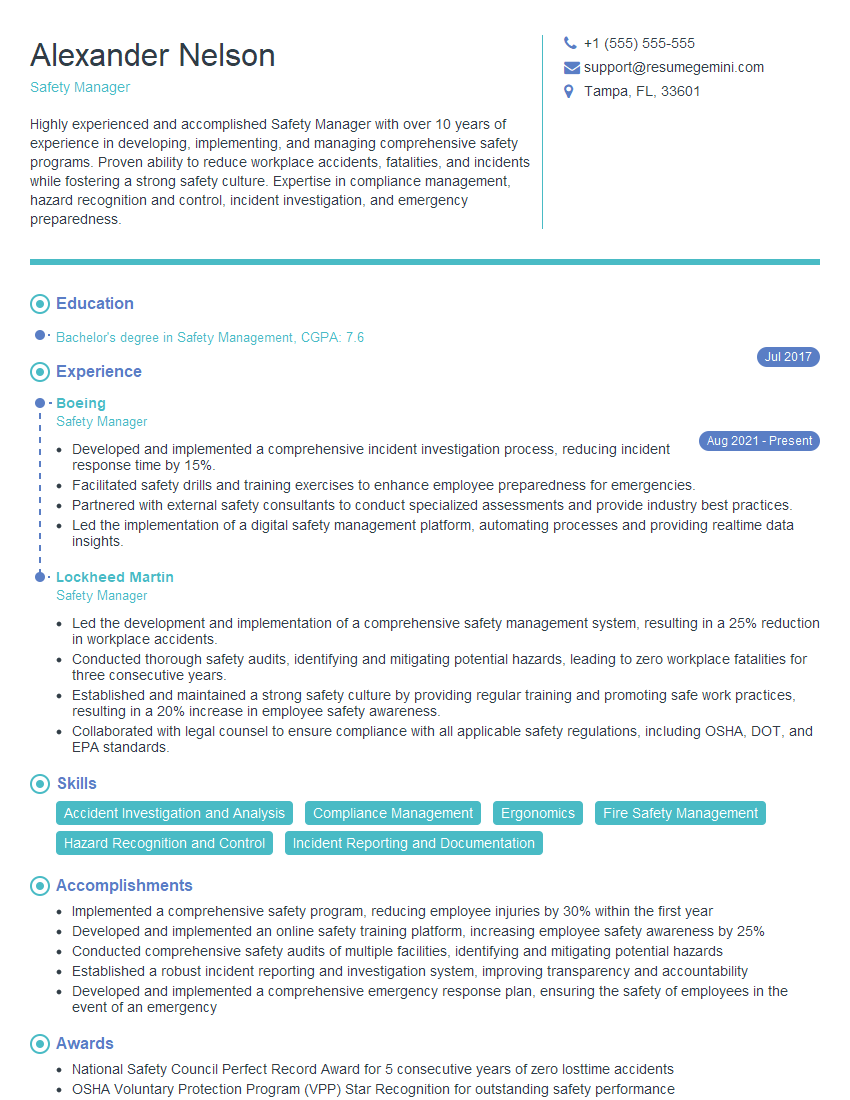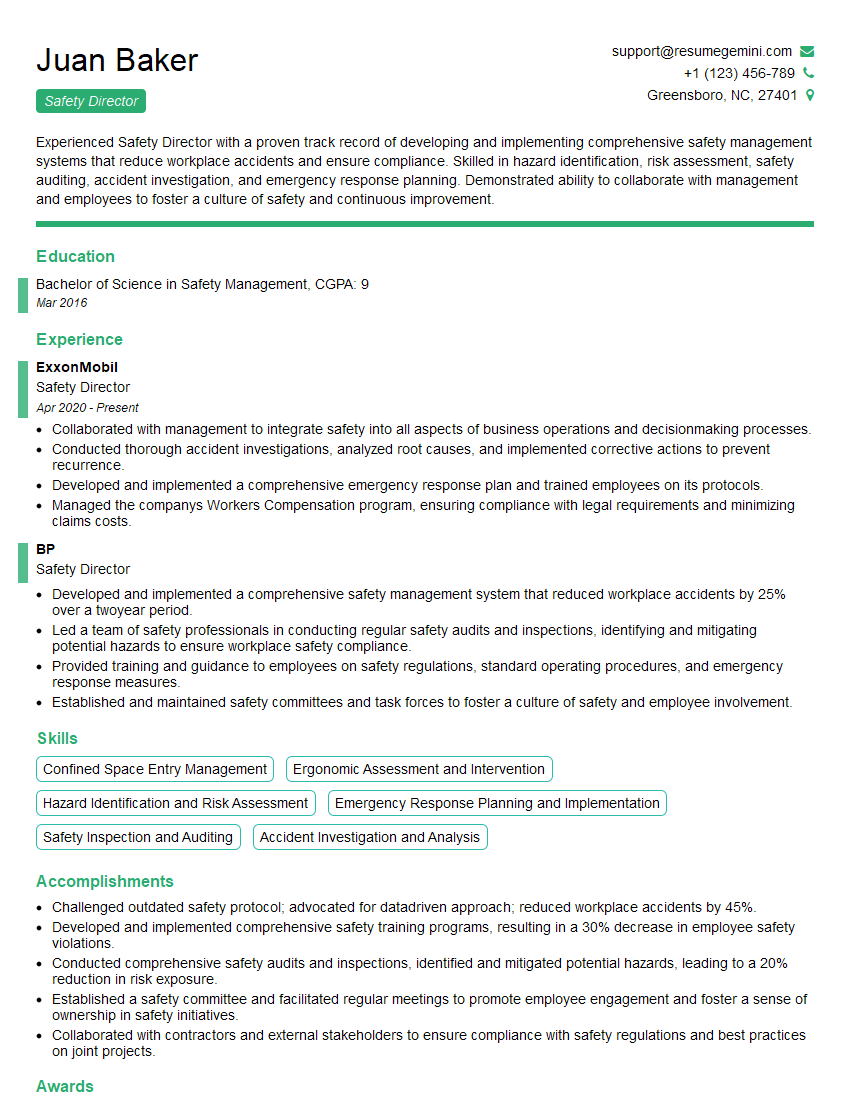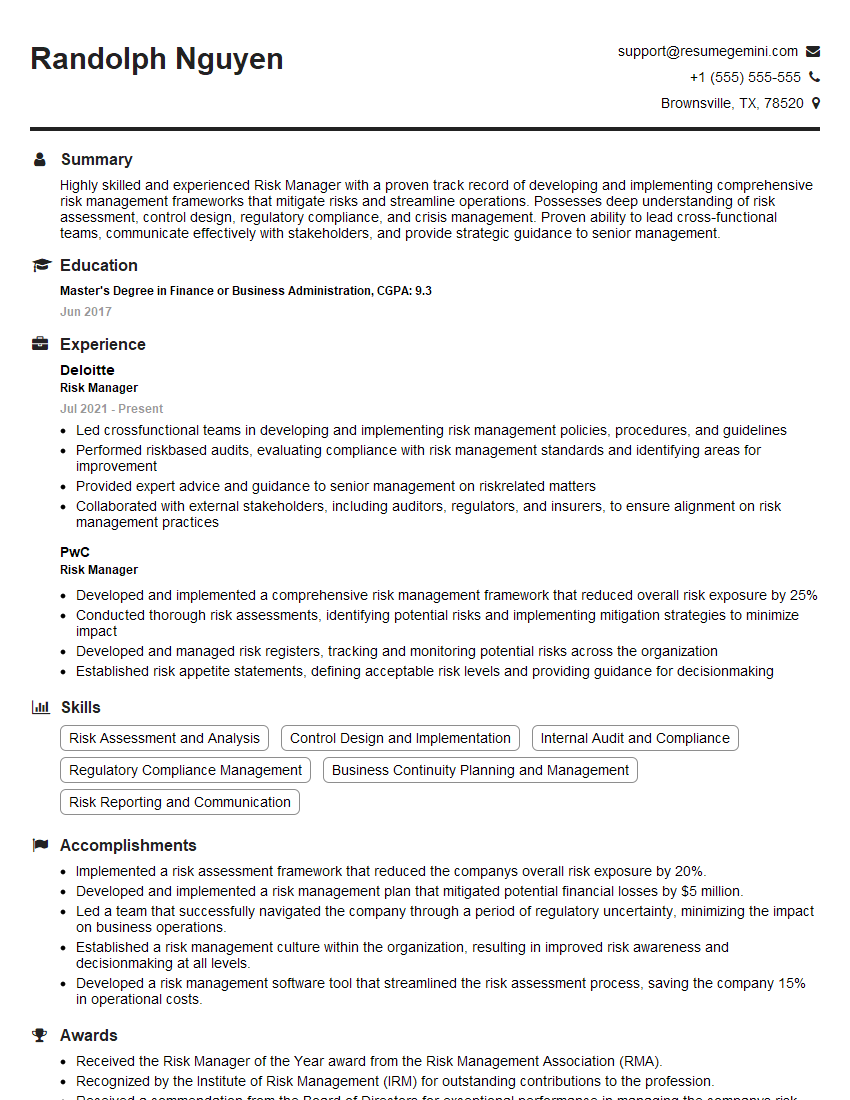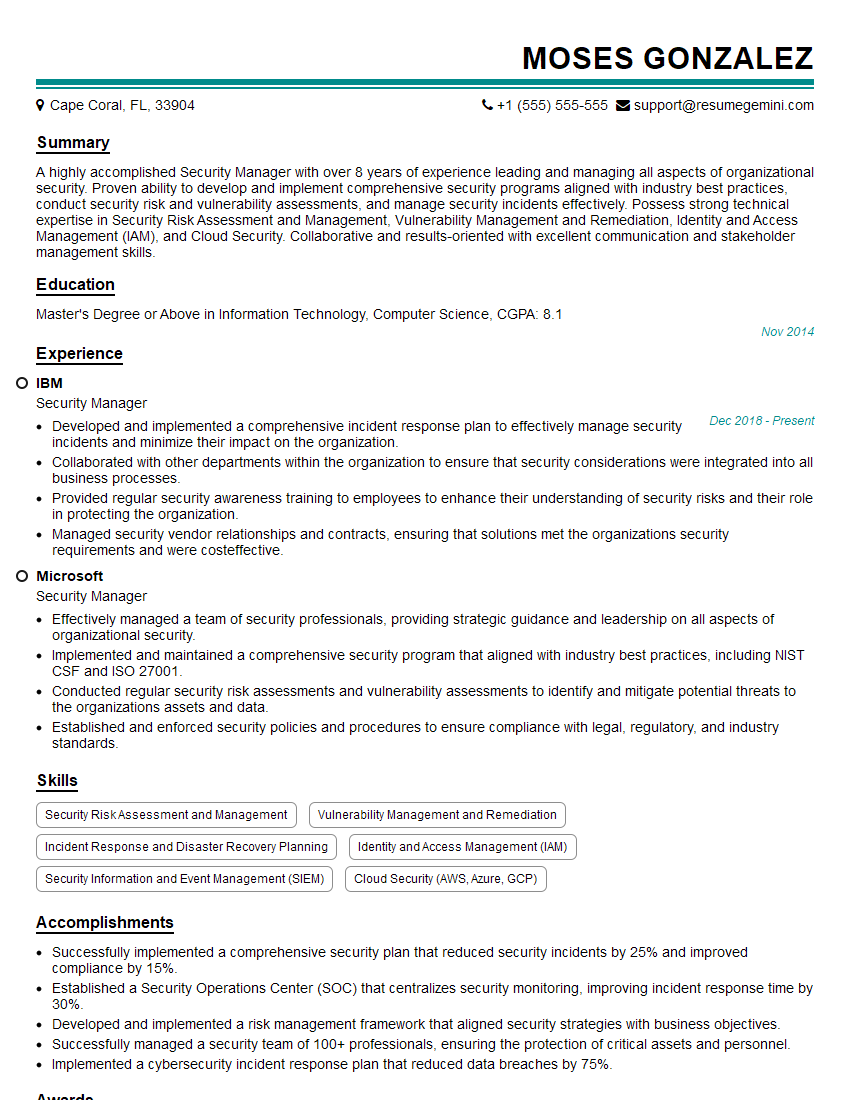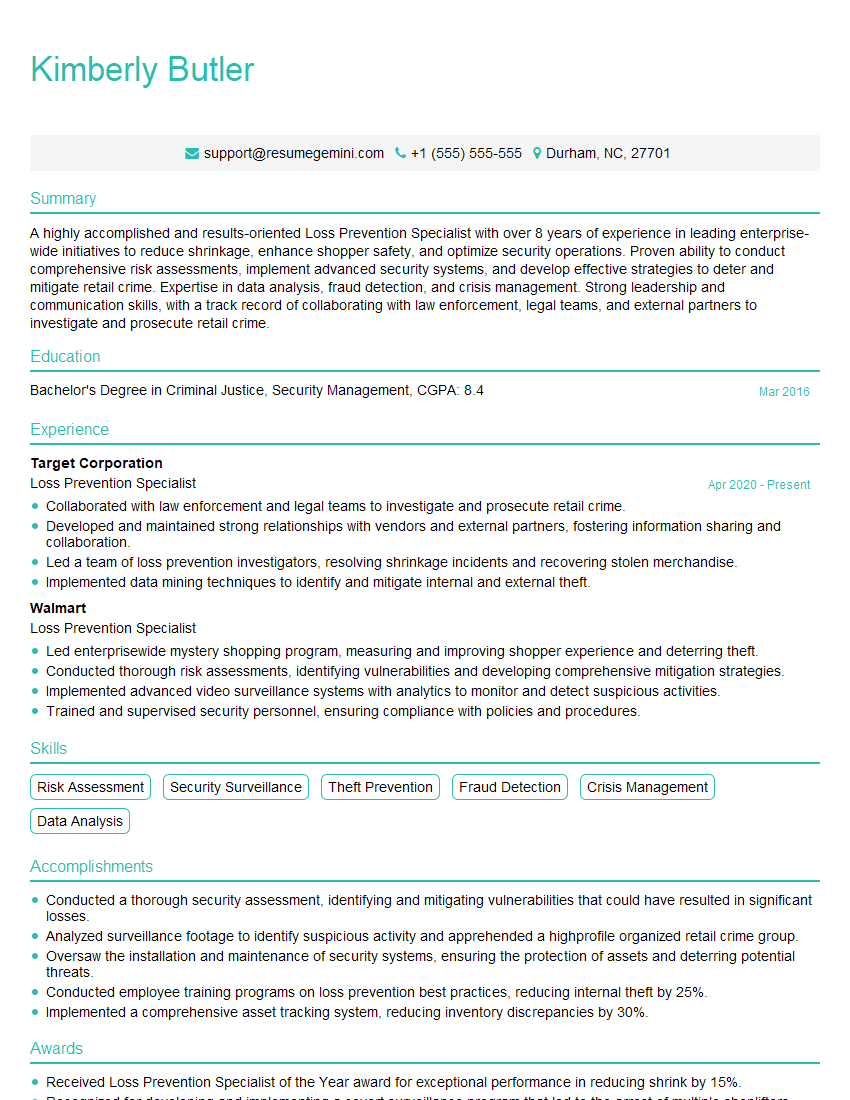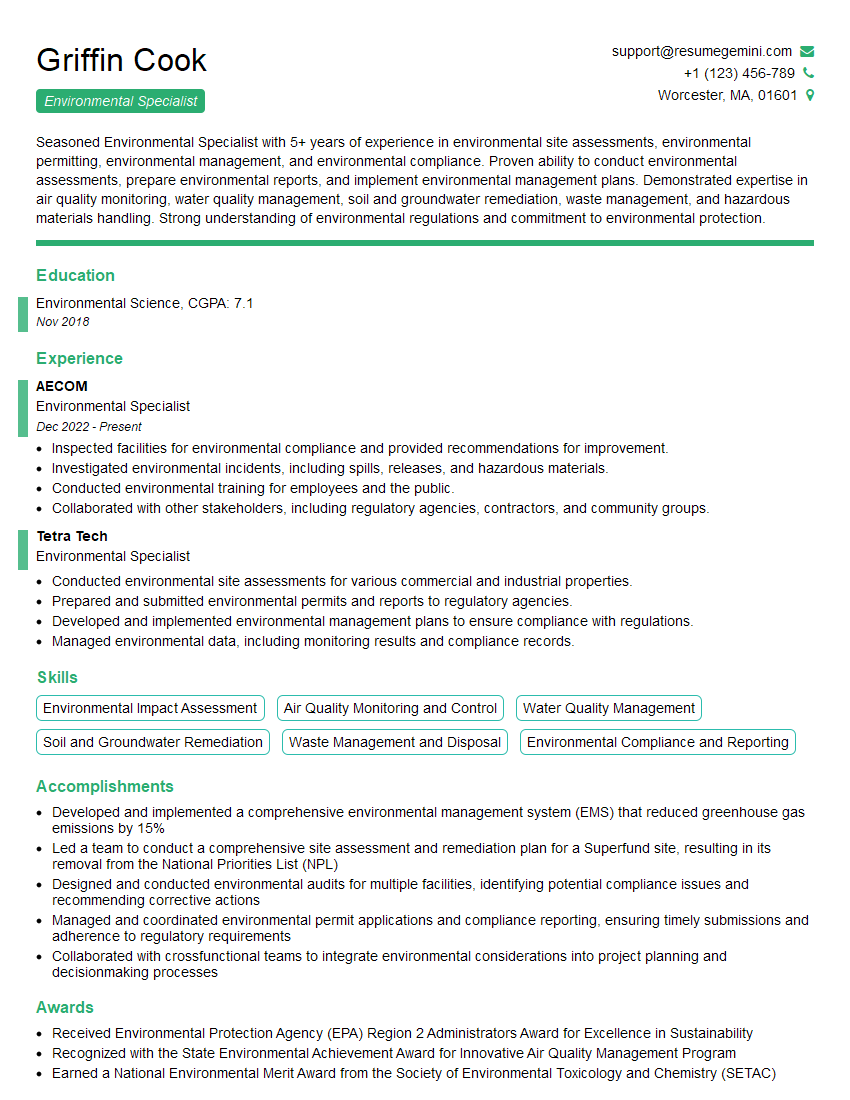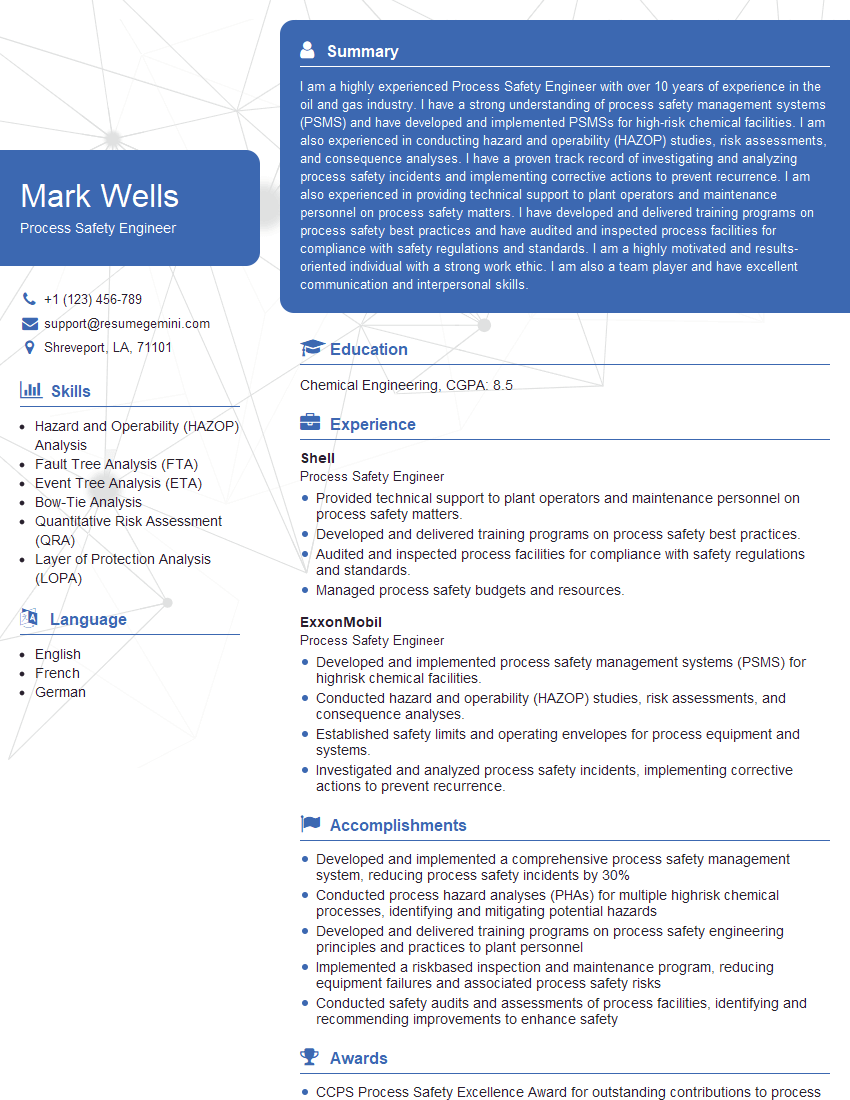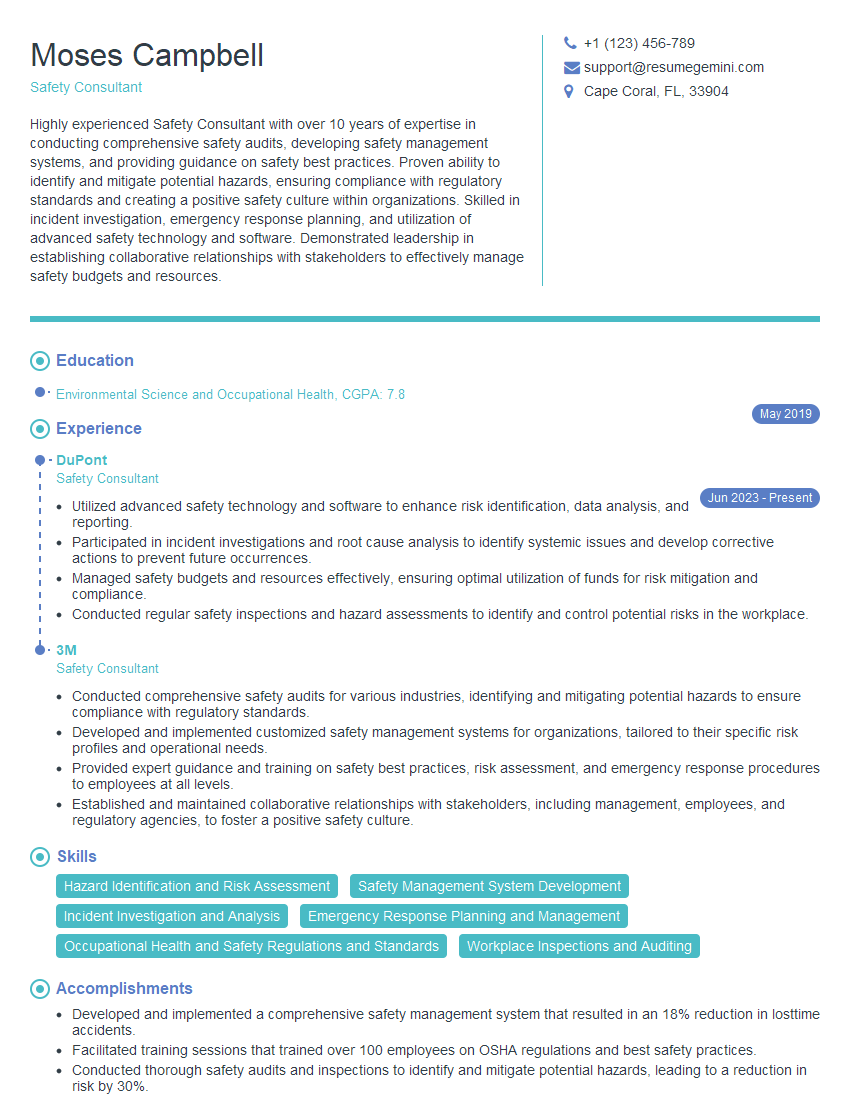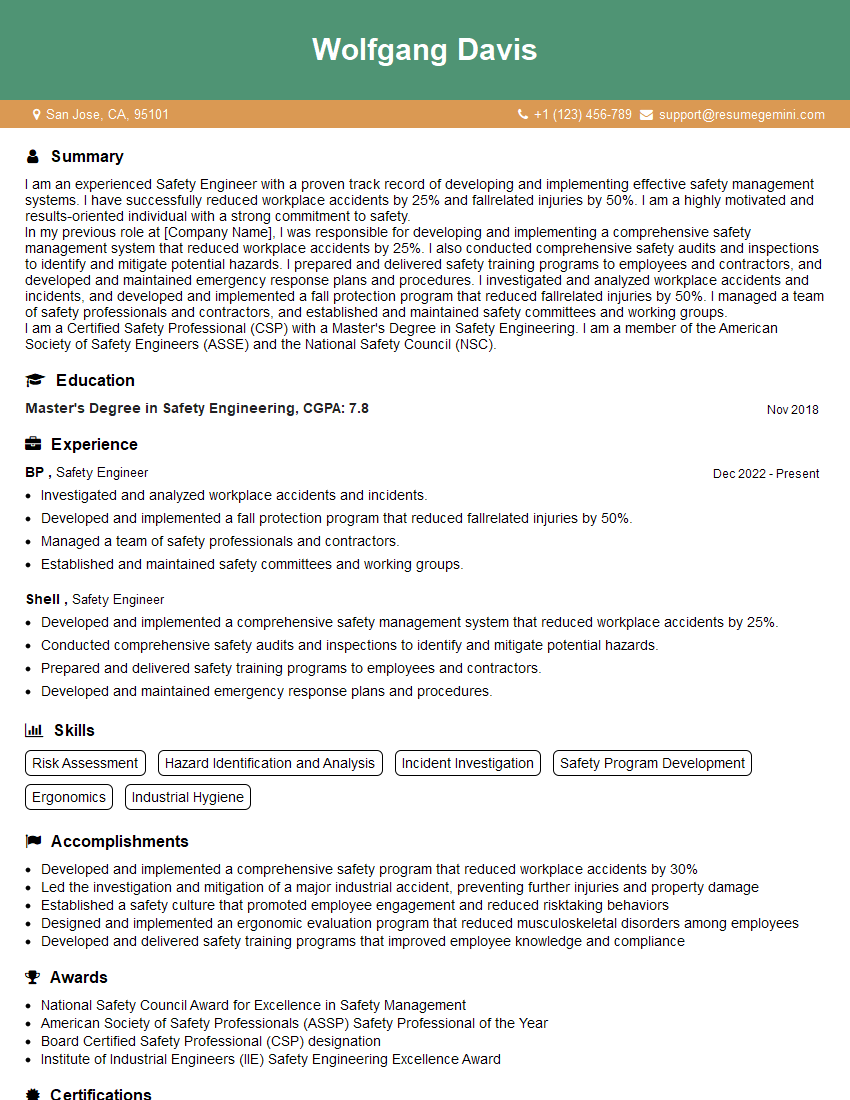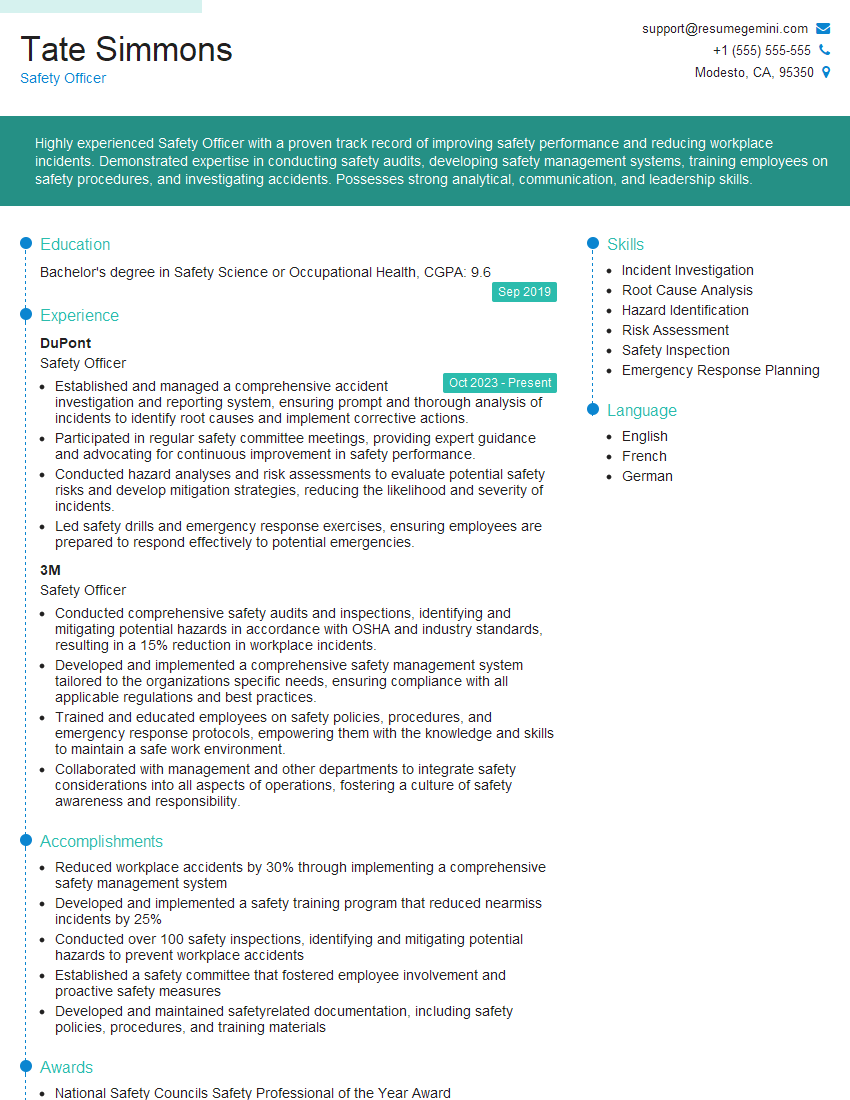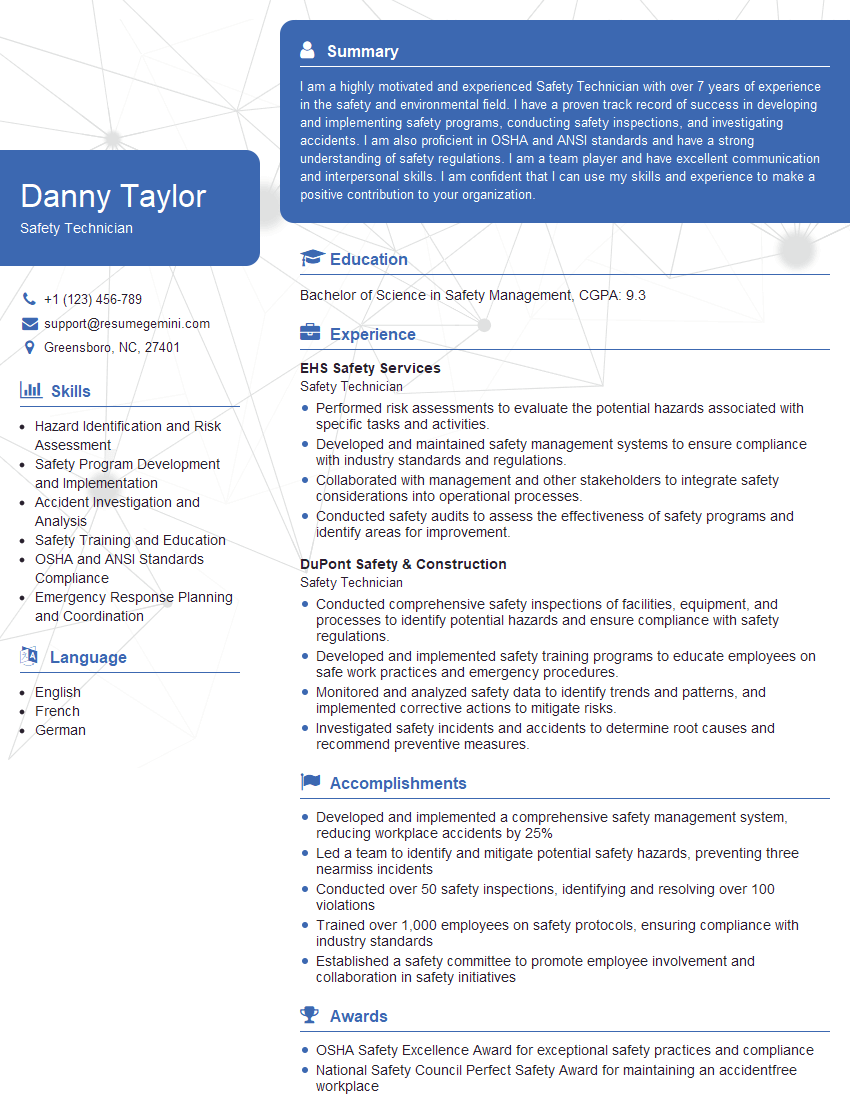The thought of an interview can be nerve-wracking, but the right preparation can make all the difference. Explore this comprehensive guide to Understanding of Safety Regulations interview questions and gain the confidence you need to showcase your abilities and secure the role.
Questions Asked in Understanding of Safety Regulations Interview
Q 1. Explain your understanding of OSHA regulations.
OSHA, the Occupational Safety and Health Administration, sets and enforces workplace safety and health standards in the United States. My understanding encompasses a broad range of its regulations, from general industry standards to those specific to construction, maritime, and agriculture. I’m familiar with OSHA’s mission to prevent work-related injuries, illnesses, and deaths. This involves understanding the General Duty Clause, which mandates employers to provide a workplace free from recognized hazards, and the specific standards addressing things like hazard communication (SDS sheets and labeling), personal protective equipment (PPE), machine guarding, lockout/tagout procedures, fall protection, and respiratory protection. I understand the importance of OSHA recordkeeping, inspections, and citations, and how to effectively address any non-compliance issues. For example, I’m well-versed in the requirements for reporting workplace fatalities and serious injuries. I also stay updated on any changes or updates to OSHA regulations.
Q 2. Describe your experience conducting safety audits.
I have extensive experience conducting safety audits, both internal and external. My approach is systematic and thorough, adhering to established checklists and industry best practices. A typical audit involves a comprehensive walk-through of the facility, observing work processes, reviewing documentation (like safety plans and training records), and interviewing employees to get their perspectives. I use a combination of observation, interviews, and document review to identify potential hazards and gaps in safety protocols. For instance, in one audit of a manufacturing plant, I discovered a lack of adequate machine guarding, leading to a recommendation for immediate corrective actions and a comprehensive retraining program for operators. My audit reports are detailed, providing clear identification of findings, root causes, and prioritized recommendations for corrective actions, always with an emphasis on practical solutions and measurable improvements.
Q 3. How do you identify and assess workplace hazards?
Identifying and assessing workplace hazards requires a multi-faceted approach. I utilize a combination of methods, including walkthroughs, job hazard analyses (JHAs), and the use of safety checklists specific to the industry and work tasks involved. A JHA, for example, systematically breaks down each step of a job to identify potential hazards and control measures. Walkthroughs allow for a visual assessment of the work environment. These methods help to identify both physical hazards (like unsafe equipment or fall hazards) and chemical hazards (exposure to toxic substances), ergonomic hazards (repetitive strain injuries), and psychosocial hazards (stress and burnout). After identification, the severity and likelihood of each hazard are assessed using a risk matrix, allowing prioritization of corrective actions. For example, a risk matrix might prioritize a hazard with high severity and high likelihood for immediate attention over a low severity, low likelihood hazard. This process enables targeted risk mitigation and prevention.
Q 4. What methods do you use to develop and implement safety programs?
Developing and implementing safety programs requires a participatory approach, involving all levels of the organization. I typically start with a thorough risk assessment, outlining existing hazards and their associated risks. Based on this assessment, I collaborate with stakeholders to develop a comprehensive safety plan that outlines specific goals, objectives, procedures, and training programs. The program should incorporate elements like hazard communication, PPE selection and use, emergency response procedures, and regular safety inspections. Implementation involves providing training, ensuring appropriate resources are available, and establishing regular monitoring and evaluation processes. For example, I developed a safety program for a construction company that incorporated a detailed fall protection plan, weekly toolbox talks, and regular safety training updates on new regulations and best practices. Continuous improvement is key – regular reviews and adjustments are crucial to maintaining program effectiveness.
Q 5. Explain your experience with incident investigation and reporting.
Incident investigation and reporting are critical for identifying root causes and preventing future occurrences. My approach follows a systematic process, beginning with immediate response and securing the scene. The investigation involves collecting evidence (photos, witness statements, equipment records), reconstructing the sequence of events, and identifying contributing factors using methods like the ‘5 Whys’ analysis to delve deeper into the root cause. The findings are documented in a detailed report, which includes recommendations to prevent similar incidents. This report is crucial for corrective actions and for complying with reporting requirements mandated by OSHA or other relevant regulatory bodies. For example, I investigated a near-miss incident where a worker almost fell from a scaffold. The investigation revealed a lack of proper guardrails and inadequate training on fall protection procedures. This resulted in immediate corrective actions and updated training materials.
Q 6. How do you ensure compliance with safety regulations?
Ensuring compliance involves a proactive and ongoing commitment. This includes staying updated on all applicable safety regulations and industry best practices. I use a variety of methods including regular safety inspections, employee training, maintaining detailed safety records, conducting periodic audits, and implementing corrective actions when necessary. This also involves close monitoring of key performance indicators (KPIs) like accident rates and near-miss reports to identify trends and address potential issues early on. Proactive communication and collaboration with employees are critical. For instance, I implemented a system for tracking and addressing employee safety concerns, ensuring that any reported hazards are investigated and addressed promptly. Ultimately, building a strong safety culture, where safety is a shared value, is the most effective way to ensure long-term compliance.
Q 7. Describe your experience with safety training and education.
I have significant experience designing and delivering safety training programs. My approach involves using a variety of methods, including classroom training, online modules, hands-on demonstrations, and job shadowing, tailoring the content to the specific needs and learning styles of the audience. I focus on practical applications and real-world scenarios to enhance engagement and knowledge retention. Effective training includes regular reinforcement and opportunities for feedback. For instance, I developed and delivered a comprehensive lockout/tagout training program for maintenance technicians, incorporating hands-on practice with actual equipment and regular quizzes to assess knowledge retention. Evaluation of training effectiveness is crucial, including pre- and post-training assessments, observation of on-the-job performance, and feedback from employees. Successful training programs significantly contribute to building a strong safety culture and reducing workplace incidents.
Q 8. How do you manage safety risks in a dynamic work environment?
Managing safety risks in a dynamic environment requires a proactive and adaptable approach. It’s not enough to have a static safety plan; you need a system that can adjust to changing conditions and emerging hazards.
My strategy involves a three-pronged approach:
- Proactive Hazard Identification: Regularly conducting job hazard analyses (JHAs) to identify potential risks, especially in new or modified processes. This involves brainstorming potential hazards, analyzing their likelihood and severity, and developing control measures. For example, if we introduce a new piece of machinery, a JHA would detail potential pinch points, electrical hazards, and noise levels, leading to the implementation of guards, safety interlocks, and hearing protection.
- Real-time Risk Assessment: Empowering workers to immediately report any unsafe conditions or near misses. This requires open communication and a ‘no blame’ culture where reporting is encouraged. A near-miss reporting system – possibly a simple online form or suggestion box – allows for the quick identification and remediation of issues before they escalate into accidents. For instance, a worker noticing a loose cable could report it preventing a potential electrocution.
- Continuous Improvement: Regularly reviewing safety performance data, investigating incidents thoroughly (root cause analysis), and implementing corrective actions. This data-driven approach allows for iterative improvement of safety measures. Analyzing accident reports, for instance, might reveal a pattern in hand injuries requiring a change in glove policy or training.
Q 9. What are your strategies for promoting a strong safety culture?
Building a strong safety culture is crucial for lasting safety improvement. It’s not just about rules and regulations; it’s about fostering a shared commitment to safety at every level of the organization. My strategies include:
- Leadership Commitment: Visible and active leadership support is paramount. Leaders should consistently model safe behaviors and champion safety initiatives, demonstrating that safety is a top priority. This could involve participating in safety training, conducting safety inspections, and publicly recognizing employees for their safety contributions.
- Employee Empowerment: Giving employees the authority and resources to stop unsafe work. This empowers them to take ownership of their safety and the safety of others. Regular safety meetings that include open dialogue and employee feedback are essential.
- Training and Communication: Providing comprehensive safety training tailored to different roles and responsibilities, along with clear and consistent communication regarding safety policies and procedures. This would include both initial training and regular refresher courses.
- Recognition and Reward: Celebrating safe work practices and recognizing employees who actively contribute to safety. This reinforces positive behavior and motivates others to prioritize safety.
- Incident Investigation and Learning: Thorough investigation of incidents, not to assign blame, but to identify root causes and implement corrective actions to prevent recurrence. This ‘learning from mistakes’ approach helps foster a culture of continuous improvement.
Q 10. How do you handle conflicts related to safety procedures?
Conflicts regarding safety procedures can arise from various sources, such as differing interpretations of rules, resistance to change, or personality clashes. My approach involves:
- Facilitation and Mediation: Creating a safe space for open discussion and addressing concerns. I would work with all parties involved to understand their perspectives and find common ground.
- Clear Communication: Ensuring everyone involved understands the relevant safety procedures and the reasoning behind them. This often involves clarifying ambiguities and addressing misconceptions.
- Objective Assessment: Objectively reviewing the safety procedures and ensuring they comply with regulations and best practices. This might involve reviewing relevant standards and industry guidelines.
- Escalation Process: If a conflict cannot be resolved through negotiation, I would follow an established escalation process, involving supervisors or management as needed to reach a fair and safe solution.
- Documentation: Thoroughly documenting all discussions, decisions, and actions taken, maintaining a clear record of the resolution process.
Ultimately, the goal is to find a solution that maintains safety standards while also addressing the concerns of all parties involved.
Q 11. Explain your experience with lockout/tagout procedures.
Lockout/Tagout (LOTO) procedures are critical for preventing accidental energization of equipment during maintenance or repair. My experience includes developing and implementing LOTO programs, training employees, and conducting regular audits to ensure compliance.
The process generally involves:
- Energy Isolation: Identifying all energy sources (electrical, mechanical, hydraulic, pneumatic, etc.) and safely isolating them.
- Lockout: Applying a lockout device to the energy isolation device to prevent the accidental re-energization of equipment.
- Tagout: Attaching a tag clearly indicating who has locked out the equipment and why.
- Verification: Verifying that the equipment is de-energized before commencing work.
- Release: Following a documented procedure to remove the lockout devices and re-energize the equipment, ensuring that only the authorized personnel perform this.
I’ve implemented LOTO programs in various settings, including manufacturing and processing plants, ensuring adherence to OSHA or equivalent regulations. I frequently conduct training emphasizing the critical nature of proper LOTO procedures and the potential consequences of non-compliance (serious injury or fatality).
Q 12. How do you ensure the proper use of personal protective equipment (PPE)?
Ensuring the proper use of PPE requires a multi-faceted approach:
- Proper Selection: Selecting the appropriate PPE for the specific hazards identified in the JHA. This might include safety glasses, hearing protection, gloves, respirators, etc. The selection must be based on the nature of the task and the associated risks.
- Training and Education: Providing thorough training on the proper selection, use, inspection, and limitations of different types of PPE. This training should include how to properly don and doff PPE, as well as the importance of regular maintenance and inspection.
- Fit Testing: Where appropriate, conducting fit testing to ensure proper fit and seal for respirators and other PPE requiring a snug fit.
- Accessibility and Availability: Making sure that PPE is readily available, easily accessible, and in good condition. This also includes adequate storage space and the availability of various sizes to accommodate different employees.
- Enforcement and Monitoring: Regularly monitoring PPE usage and enforcing the policy to ensure compliance. This includes safety inspections and addressing any non-compliance issues promptly. This may involve disciplinary action in serious cases.
- Maintenance and Replacement: Implementing a system for inspecting and maintaining PPE regularly and replacing it as needed, keeping records of inspection, cleaning, and replacement.
Q 13. Describe your knowledge of emergency response plans.
My knowledge of emergency response plans encompasses their development, implementation, and regular review. A well-designed emergency response plan should address all foreseeable emergencies, including:
- Fire Emergencies: Evacuation procedures, fire suppression techniques, and roles and responsibilities of emergency response teams.
- Hazardous Material Spills: Procedures for containing and cleaning up spills, as well as emergency notification protocols.
- Medical Emergencies: First aid procedures, emergency medical services (EMS) notification, and emergency medical care.
- Natural Disasters: Procedures for dealing with events like earthquakes, floods, or severe weather.
- Workplace Violence: Procedures for addressing threats or actual acts of violence.
The plan should include clear communication protocols, detailed emergency procedures, emergency contact information, designated assembly points, and regular training exercises to ensure preparedness.
I have experience in developing and implementing such plans, ensuring they are tailored to the specific hazards and risks present in a given environment. The plans should be regularly reviewed and updated to reflect changes in the workplace or improvements in emergency response technologies.
Q 14. How do you conduct safety inspections and document findings?
Safety inspections are crucial for proactively identifying and mitigating hazards. My approach to conducting safety inspections and documenting findings includes:
- Planned Inspections: Scheduling regular inspections based on risk assessment, focusing on areas with high-risk activities or equipment.
- Checklist Utilization: Using a standardized checklist to ensure consistency and thoroughness. This checklist includes specific items to check, based on the area and type of equipment.
- Observation and Documentation: Thoroughly observing the workplace, noting any unsafe conditions, practices, or equipment deficiencies. I use photos and videos to document significant findings.
- Corrective Actions: Identifying corrective actions for each finding, assigning responsibility, and establishing deadlines for completion.
- Follow-up Inspections: Conducting follow-up inspections to verify that corrective actions have been implemented effectively.
- Reporting and Communication: Preparing comprehensive reports that detail the findings, corrective actions, and follow-up status. These reports are shared with management and relevant personnel.
- Data Analysis: Analyzing inspection data over time to identify trends and patterns that might indicate systemic safety issues.
The documentation needs to be clear, concise, and legally compliant. The goal is not just to identify problems but to improve safety performance over time, using this data for continuous improvement.
Q 15. How familiar are you with different types of safety regulations (e.g., ISO, ANSI)?
My familiarity with safety regulations extends across various standards organizations. I have extensive experience with ISO standards, particularly ISO 45001 (Occupational health and safety management systems), which provides a framework for proactively managing workplace risks. I’m also well-versed in ANSI (American National Standards Institute) standards, frequently used in the US for safety in specific industries like manufacturing (e.g., ANSI B11 for machinery safety) and construction. Beyond ISO and ANSI, my knowledge encompasses OSHA (Occupational Safety and Health Administration) regulations in the US, as well as other regionally specific regulations depending on the project or industry. Understanding the nuances between these standards is crucial for effective safety management, as they often have overlapping yet distinct requirements. For instance, while both ISO 45001 and OSHA aim for a safe workplace, their implementation approaches and specific requirements differ.
Career Expert Tips:
- Ace those interviews! Prepare effectively by reviewing the Top 50 Most Common Interview Questions on ResumeGemini.
- Navigate your job search with confidence! Explore a wide range of Career Tips on ResumeGemini. Learn about common challenges and recommendations to overcome them.
- Craft the perfect resume! Master the Art of Resume Writing with ResumeGemini’s guide. Showcase your unique qualifications and achievements effectively.
- Don’t miss out on holiday savings! Build your dream resume with ResumeGemini’s ATS optimized templates.
Q 16. Explain your understanding of risk assessment methodologies.
Risk assessment methodologies are crucial for identifying and evaluating potential hazards. A common approach is the HAZOP (Hazard and Operability Study) method, which systematically examines a process or system to identify potential deviations from intended operation and their consequences. Another widely used method is FMEA (Failure Mode and Effects Analysis), which focuses on identifying potential failure modes of individual components or processes and their impact on the overall system. Both methods typically involve a multi-disciplinary team, brainstorming potential hazards, evaluating their likelihood and severity, and determining appropriate control measures. For example, in a chemical plant, HAZOP might be used to analyze the entire production process, identifying potential leaks, explosions, or human errors, while FMEA could be used to assess the reliability of individual pumps or valves. The outcome of these assessments is a prioritized list of risks, forming the basis for risk mitigation strategies.
Q 17. How do you prioritize safety risks and allocate resources accordingly?
Prioritizing safety risks involves a combination of qualitative and quantitative assessments. We typically use a risk matrix, plotting the likelihood and severity of each identified hazard. This allows for a visual representation of the relative risk level. For example, a hazard with high likelihood and high severity would be prioritized over one with low likelihood and low severity. Resource allocation follows this prioritization, focusing on mitigating high-risk hazards first. This might involve implementing engineering controls (e.g., installing safety guards on machinery), administrative controls (e.g., implementing stricter work procedures), or personal protective equipment (PPE). Budgetary constraints are considered, but safety should never be compromised solely due to cost. A cost-benefit analysis might be performed, but the primary focus remains on minimizing risk to life and limb.
Q 18. How do you communicate safety information effectively to various audiences?
Effective communication is paramount in safety management. It’s crucial to tailor communication to different audiences. For highly technical personnel, detailed risk assessments and safety data sheets are appropriate. For less technically skilled workers, simpler communication methods like visual aids, checklists, and concise training materials are more effective. Regular safety meetings, toolbox talks, and the use of multiple communication channels (e.g., posters, emails, intranet) are essential to ensure everyone is informed. Using plain language, avoiding jargon, and actively seeking feedback are vital for clear and effective communication. For example, a complex chemical process safety analysis wouldn’t be effectively communicated to a warehouse worker via a lengthy report but might be conveyed effectively with a simple infographic summarizing key safety procedures.
Q 19. Describe your experience with safety data sheets (SDS) and their application.
Safety Data Sheets (SDS) are crucial documents providing information on hazardous materials. My experience includes reviewing, interpreting, and ensuring compliance with SDS requirements. I use SDS information to develop appropriate handling procedures, storage guidelines, and emergency response plans. For example, when introducing a new chemical into a workplace, the SDS is the primary source of information on its hazards (e.g., flammability, toxicity), recommended personal protective equipment, and emergency procedures. I ensure that all employees handling the material receive proper training based on the SDS information. Furthermore, I ensure that SDS are readily accessible to all relevant personnel and kept up-to-date.
Q 20. How do you measure the effectiveness of safety programs?
Measuring the effectiveness of safety programs involves both leading and lagging indicators. Lagging indicators reflect past performance, such as the number of accidents or injuries. Leading indicators focus on preventative measures and proactive behaviors, such as the number of safety training hours completed or the frequency of safety inspections. Key performance indicators (KPIs) are established to track progress. These could include the number of near misses reported, the implementation rate of corrective actions, and employee satisfaction with safety procedures. Regular monitoring and analysis of these KPIs, along with periodic audits and safety surveys, provide valuable data for continuous improvement of the safety program. A decrease in accident rates and an increase in safety training participation would be positive indicators of a successful program.
Q 21. How do you stay updated on changes in safety regulations?
Staying updated on safety regulations requires a multi-pronged approach. I regularly subscribe to professional journals and newsletters, attend industry conferences and workshops, and participate in relevant online forums and training programs. I also actively monitor the websites of regulatory bodies such as OSHA and relevant international organizations. Membership in professional safety organizations provides access to updated information and networking opportunities. Furthermore, I maintain a system for tracking changes in regulations and ensuring that our safety programs remain compliant. This proactive approach ensures that our safety practices remain current and effective.
Q 22. How do you handle situations where safety regulations conflict?
When safety regulations conflict, it’s crucial to prioritize the most stringent and relevant standard. This often involves a careful analysis of the specific circumstances and the potential risks involved. I approach this by first identifying the conflicting regulations. Then, I consult the relevant regulatory documents, industry best practices, and internal policies to determine which regulation offers the highest level of protection. If the conflict is significant and there’s no clear precedence, I would consult with senior safety professionals or legal counsel to ensure the most compliant and safe solution is implemented. For example, if a local regulation allows a slightly higher noise level than a national standard, I’d always adhere to the more protective national standard.
This process involves careful documentation of the conflict, the decision-making process, and the rationale behind choosing one regulation over another. This documentation serves as a record of the risk assessment and ensures transparency and accountability.
Q 23. Describe a time you had to resolve a safety issue that was beyond the scope of your standard procedures.
During a large-scale construction project, we experienced an unexpected surge in dust levels significantly exceeding our permitted limits. Our standard procedures addressed routine dust control, but this event demanded a more immediate and comprehensive solution. We couldn’t simply follow the standard cleaning schedule; the elevated dust posed an immediate respiratory health risk to workers.
My response involved a multi-pronged approach. First, I immediately halted all non-essential work in the affected area. Then, we deployed additional high-powered vacuum systems and implemented a more frequent cleaning schedule. We also implemented respiratory protection for all personnel working in the area and increased air monitoring frequency. Finally, I initiated a root cause analysis to understand the source of the elevated dust and implement preventative measures to avoid future incidents. This involved reviewing the construction methods, equipment usage, and environmental factors.
The situation highlighted the importance of adaptability and proactive risk management beyond standard procedures. It reinforced the need for a dynamic safety program capable of responding to unforeseen circumstances.
Q 24. What is your experience with ergonomic assessments and hazard control?
I have extensive experience conducting ergonomic assessments and implementing hazard controls. My approach involves a combination of observation, data collection, and worker interviews. I use tools like the Rapid Upper Limb Assessment (RULA) and Rapid Entire Body Assessment (REBA) to evaluate workstation setups and identify potential musculoskeletal disorders (MSDs) risks.
Once hazards are identified, I apply the hierarchy of controls, starting with elimination (removing the hazard entirely), followed by substitution (replacing the hazard with a safer alternative), engineering controls (modifying the work environment), administrative controls (changing work practices), and finally, personal protective equipment (PPE) as a last resort.
For example, in a manufacturing setting, I identified repetitive strain injuries as a potential hazard. Through an ergonomic assessment, we found that adjusting the workstation height and implementing shorter work cycles significantly reduced the risk. In this case, engineering and administrative controls were prioritized over PPE alone. I also document all findings, recommendations, and implemented changes for ongoing monitoring and continuous improvement.
Q 25. How do you manage safety in remote or challenging work environments?
Managing safety in remote or challenging environments requires a comprehensive, proactive approach. It goes beyond standard workplace safety protocols and necessitates meticulous planning and robust communication. This includes rigorous risk assessments that specifically address the unique hazards of the environment—things like extreme weather, challenging terrain, wildlife encounters, and limited access to emergency services.
My strategy involves detailed pre-job briefings covering potential hazards, emergency procedures, and communication protocols. We equip workers with appropriate personal protective equipment (PPE) and specialized training for the specific environment. Real-time communication systems, such as satellite phones or two-way radios, are essential to ensure rapid response in emergencies. Regular check-ins and robust reporting systems are crucial to monitor worker well-being and identify potential issues promptly. For instance, in a remote forestry operation, we’d establish regular check-in points, provide GPS trackers, and ensure all workers carry emergency beacons.
Q 26. Explain your understanding of the hierarchy of controls in hazard management.
The hierarchy of controls is a fundamental principle in hazard management. It prioritizes control measures to minimize risks, starting with the most effective and moving to less effective measures only if necessary. The order is generally:
- Elimination: Completely removing the hazard. Example: Replacing a hazardous chemical with a safer alternative.
- Substitution: Replacing the hazard with a less hazardous alternative. Example: Using a less toxic cleaning agent.
- Engineering Controls: Isolating people from the hazard. Example: Installing guarding on machinery.
- Administrative Controls: Changing the way work is done. Example: Implementing a work rotation schedule to limit exposure.
- Personal Protective Equipment (PPE): Protecting the worker from the hazard. Example: Providing safety glasses, hearing protection or respirators.
This hierarchy ensures that the most effective control measures are implemented first, minimizing reliance on PPE which is often the least effective and only a last resort.
Q 27. How do you ensure that safety procedures are effectively integrated into daily operations?
Integrating safety procedures into daily operations requires a multifaceted approach focusing on training, communication, and accountability. It’s not enough to have a safety manual; procedures must be embedded in the workflow.
This involves providing comprehensive training to all employees on relevant safety procedures. This training should be practical, engaging, and include regular refresher courses. Regular safety meetings, toolbox talks, and visual aids like safety posters and checklists reinforce safety awareness. We use a system of regular inspections, audits, and near-miss reporting to identify areas for improvement and ensure compliance. Incentivizing safe work practices through reward programs also encourages active participation. Clear lines of communication—employees feeling comfortable reporting concerns without fear of retribution—are vital to a successful safety program.
Q 28. Describe your experience working with contractors and ensuring their compliance with safety standards.
Working with contractors necessitates a robust system to ensure their compliance with safety standards. Before engaging any contractor, I thoroughly review their safety records, insurance certifications, and safety management systems. Pre-work meetings are essential to clearly outline safety expectations, project-specific hazards, and emergency procedures. These meetings often involve reviewing site-specific safety plans and ensuring the contractor has the necessary training, equipment, and PPE.
Throughout the project, we maintain regular communication and conduct site inspections to monitor the contractor’s compliance. Any non-compliance is addressed promptly through corrective actions, further training, or, if necessary, removal from the project. We also integrate contractor safety performance into our overall project evaluation. This rigorous approach ensures that all parties share responsibility for maintaining a safe work environment, regardless of employment status.
Key Topics to Learn for Understanding of Safety Regulations Interview
- Occupational Safety and Health Act (OSH Act) and Regulations: Understand the core principles, employer and employee responsibilities, and common violations.
- Hazard Identification and Risk Assessment: Learn methods for identifying potential hazards (e.g., chemical, physical, biological), conducting risk assessments, and implementing control measures (elimination, substitution, engineering controls, administrative controls, PPE).
- Personal Protective Equipment (PPE): Know the different types of PPE, their appropriate applications, limitations, and proper use and maintenance.
- Emergency Response Procedures: Familiarize yourself with emergency action plans, evacuation procedures, fire safety, and first aid protocols.
- Accident Investigation and Reporting: Understand the process of investigating accidents, identifying root causes, and implementing corrective actions to prevent recurrence. Learn about relevant reporting requirements.
- Safety Training and Communication: Understand the importance of effective safety training programs, communication strategies, and documentation.
- Specific Industry Regulations: Research safety regulations specific to your target industry. This demonstrates specialized knowledge and commitment.
- Regulatory Compliance and Audits: Understand the importance of maintaining compliance with safety regulations and the process of internal and external audits.
- Data Analysis and Safety Metrics: Familiarize yourself with using safety data to track performance, identify trends, and improve safety outcomes.
Next Steps
Mastering your understanding of safety regulations is crucial for career advancement in virtually any industry. A strong grasp of these concepts demonstrates your commitment to workplace safety and your ability to mitigate risks, making you a valuable asset to any organization. To significantly boost your job prospects, create an ATS-friendly resume that highlights your safety expertise. ResumeGemini is a trusted resource for building professional resumes that stand out. Use their tools and resources to craft a compelling resume that showcases your skills and experience. Examples of resumes tailored to Understanding of Safety Regulations are provided to help you get started.
Explore more articles
Users Rating of Our Blogs
Share Your Experience
We value your feedback! Please rate our content and share your thoughts (optional).
What Readers Say About Our Blog
This was kind of a unique content I found around the specialized skills. Very helpful questions and good detailed answers.
Very Helpful blog, thank you Interviewgemini team.
